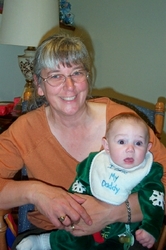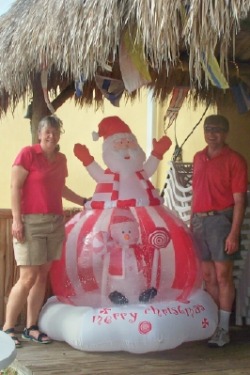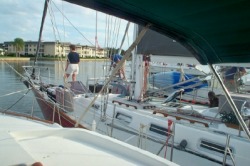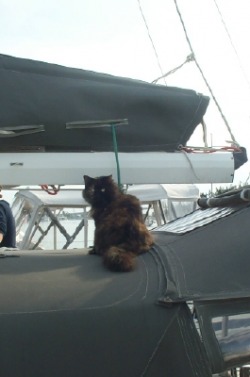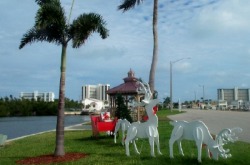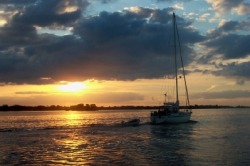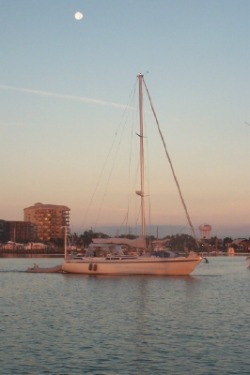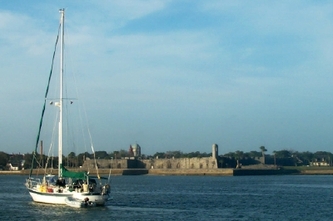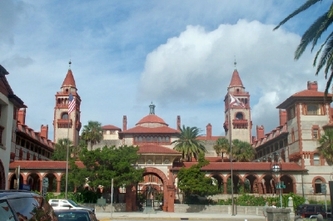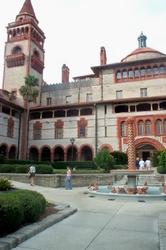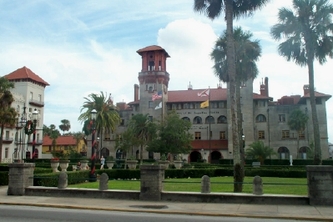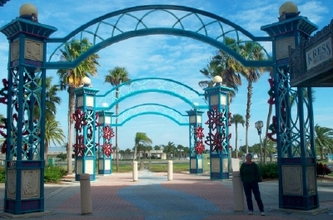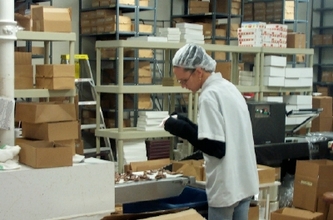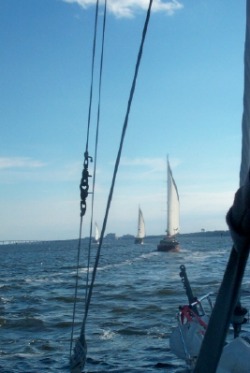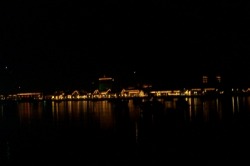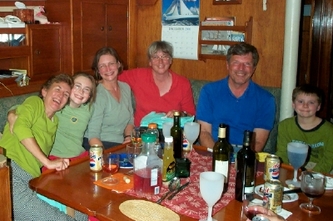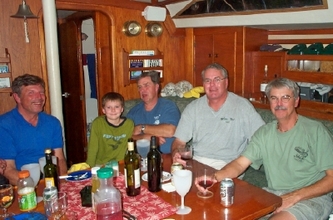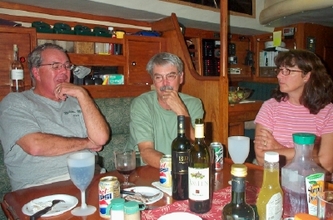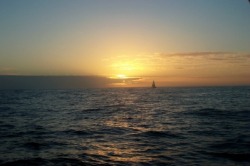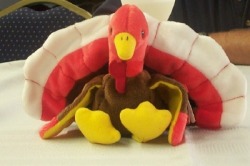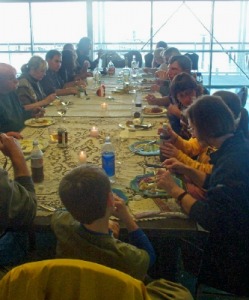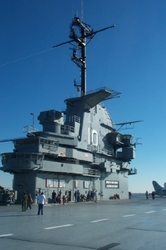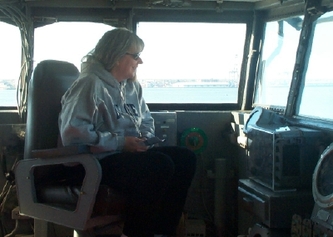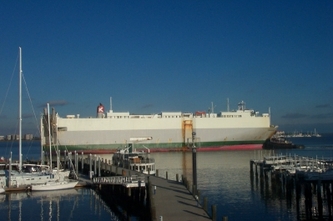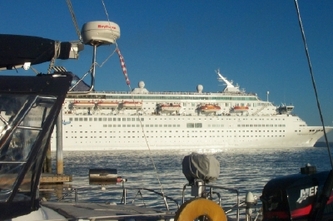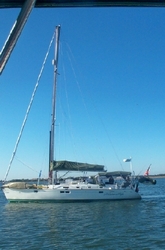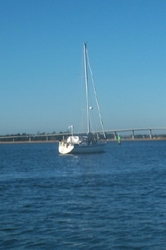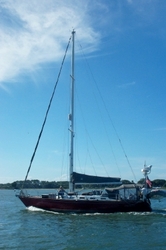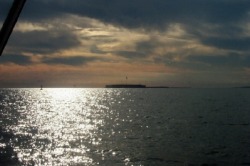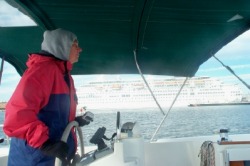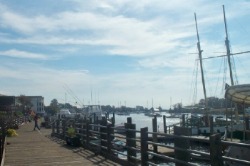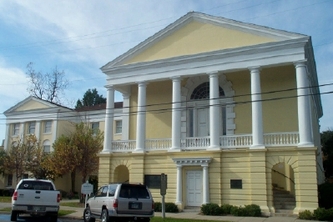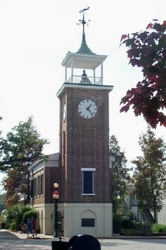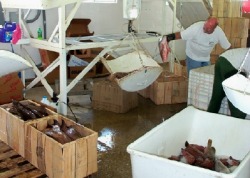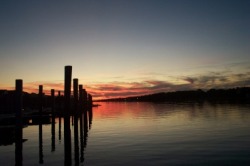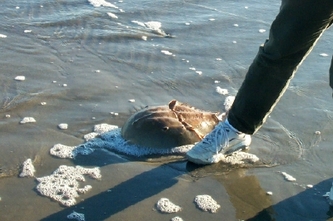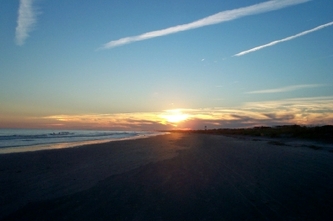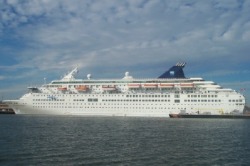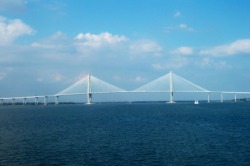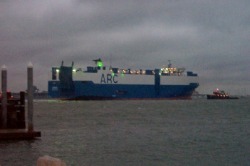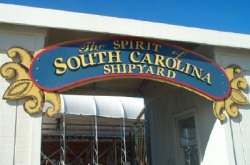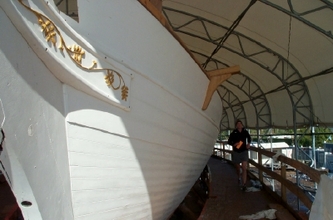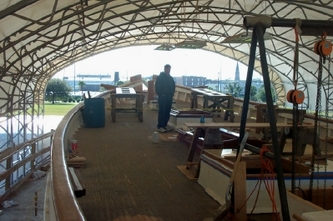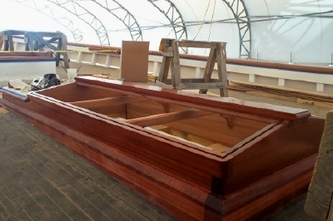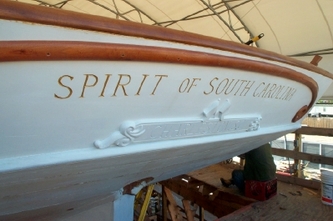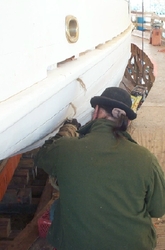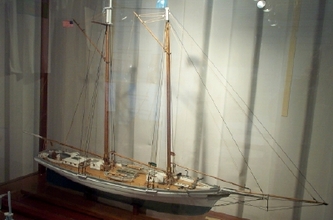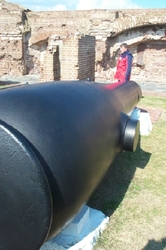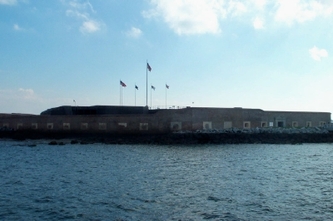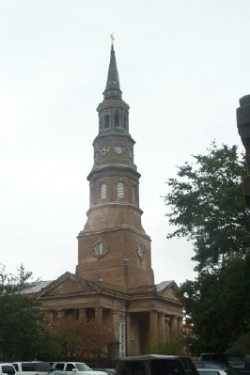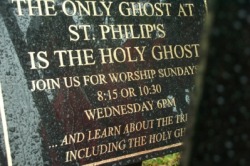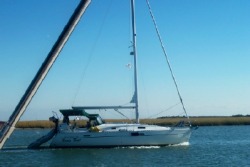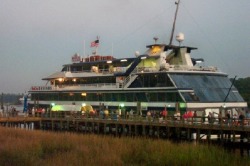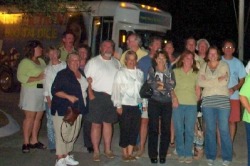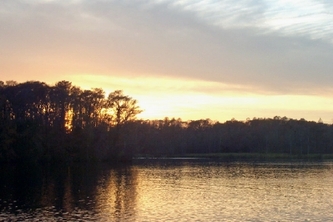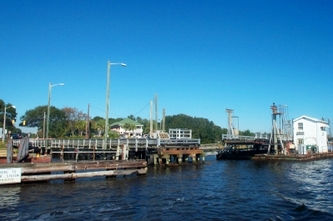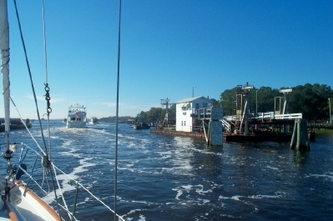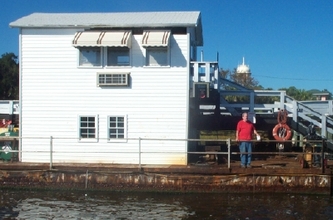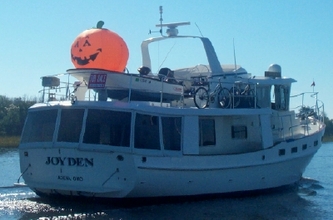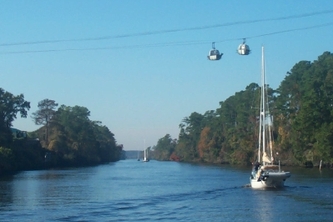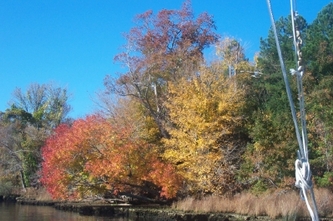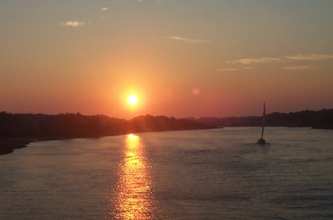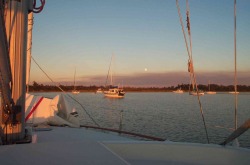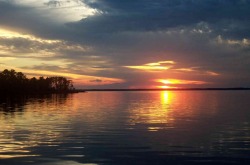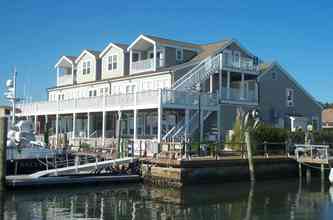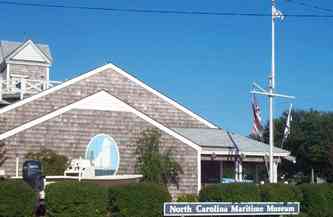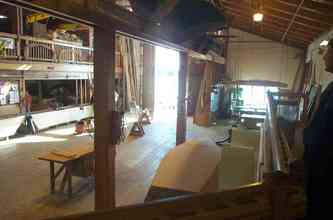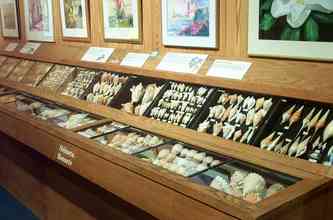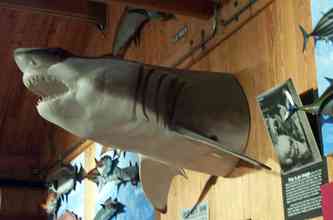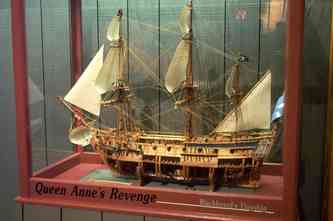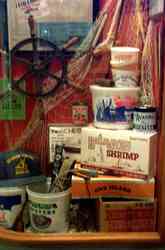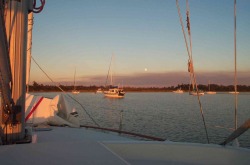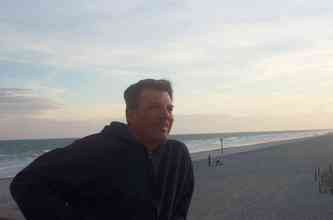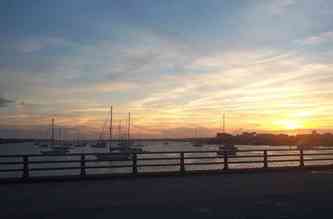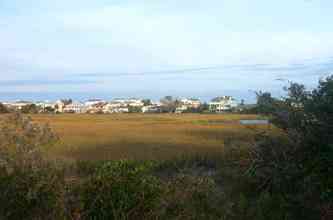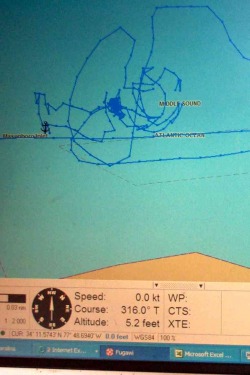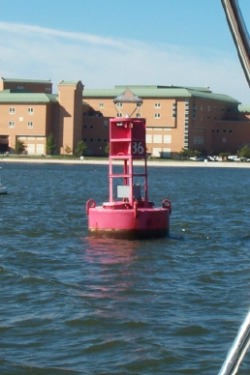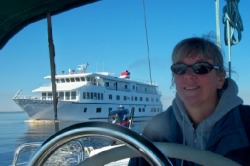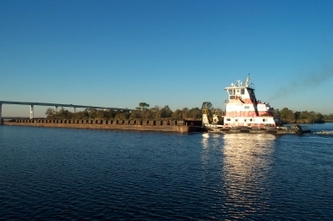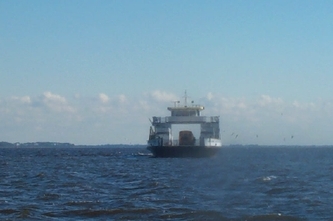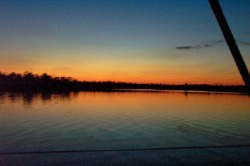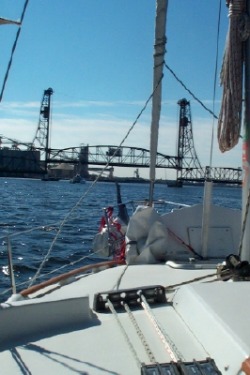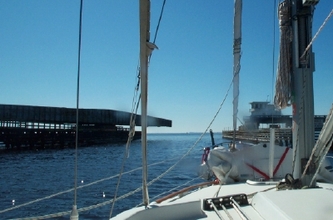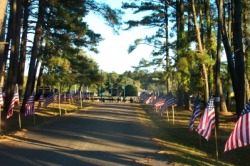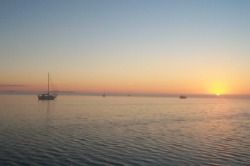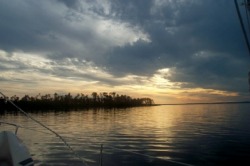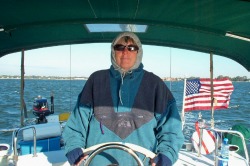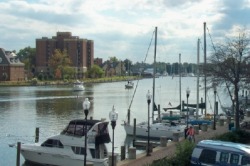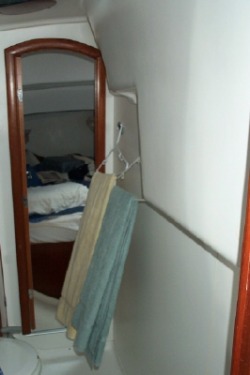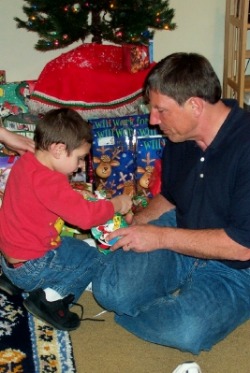
We traveled almost 3000 miles in the last 2 weeks of 2006, visiting family and friends in New York, Virginia, and North Carolina before returning to Florida just before New Year’s Eve. Pat and Fred, our friends (and currently neighbors) on Marianna, flew back to New Hampshire for the holidays and were back just in time to celebrate New Year’s eve at Nettles Island. We were delighted to find that Donna and Dave on Merlin came to Nettles Island from Vero Beach on New Year’s eve, so that we could bring in 2007 together.
Preparing to Leave
We were told when we pulled into Nettles Island Marina that we were not in our permanent slip and would have to move Orion before we left for the holidays. This was becoming problematic, since the wind refused to die down enough for us to feel a move could be done safely. Also, it wasn’t apparent that the marina knew where we were to go.
We ended up moving to a slip much too big for us that was up against the inside corner of the fairway. This can be a particularly tricky maneuver, since we needed to back into the slip to ensure our electric lines would reach, but stay off the dock in the process of turning. We finally were able to move in lighter winds the morning before we planned to depart to points north. We were thankful for many helpful hands on the dock to ease Orion into her slip.
Given the roomy slip, Dave spent a long time working on the lines to ensure Orion was centered in the slip, and therefore unlikely to bounce against either pier or piling during the weeks we would be away. When he proudly displayed his accomplishment, Cathy viewed the 5 foot gap between the boat and pier, with much less than the enthusiastic praise he was expecting.
Given the fixed docks at Nettles, the difficulty of hanging fenders in exactly the right position to protect from bashing into the vertical pilings is tricky. Getting it wrong means you can end up with some big gouges in the hull. A fellow slipholder at Nettles was making a fender board for himself and asked if we wanted one as well. How could we refuse? The fender board is placed on the outside of 2 fenders, and takes the impact with the piling, distributing the force to both fenders. It expands the horizontal coverage of the fenders to several feet, ensuring they will take the impact.
Christmas Gifts
Amidst all the shopping for Christmas gifts (which had to be crammed into the few days with access to the car or done online), we also continued to look at the requirements for an extended stay in the Bahamas, where almost everything, from food staples to spare parts are either difficult to find or very expensive or (more likely) both. The mantra for a trip to the Bahamas is, if you need it, take it with you.
Dave consulted with Fred on Marianna and Dave on Merlin to come up with some additions to the engine spare parts that we already carried. The likelihood of needing to replace a clogged fuel filter or impeller while underway on the ocean is high, due to the stirring up of the fuel tanks by a rough passage. The difficulty of doing anything in rough weather at sea was brought home by our most recent trip on the ocean. To make this easier, it was recommended that we get a spare water pump, complete with a bracket and impeller to simplify the replacing of an impeller. Similarly, we needed a fuel filter bowl for our Racor fuel filter. This could be assembled with the filter in advance and simply swapped for the clogged engine filter when underway. Fuel problems could clog the injector, which prompted us to order one of these as well.
Ongoing maintenance required us to order additional Racor fuel filters (we carry 5 spare on board now, 1 assembled) and oil filters (we have 5 spare). When ordering these from Bayshore Marine, they recommended a spare bleed screw as well, which, of course, we ordered.
We were starting to have some more problems with the engine starting on the starter battery, which we had suspected might be due to the rebuilt starter installed in May. So, Dave ordered a new starter to eliminate this as a possible reason for the problems, which would also give us a spare.
Fuel and water are harder to get in the Bahamas, so it makes sense to carry more on board. We had enough gas cans for this purpose (to fuel the generator and dinghy), but lacked the number we felt we needed for diesel and water. Although we could find the diesel cans many places, they were often outrageously expensive. We finally found some at a small auto parts store in Emporia, VA. The water cans are hard to find, but we stumbled across a K-mart that carried them in Pennsylvania, as we traveled back from NY.
Our computer is a critical tool on the boat, since we do all our route planning, e-mail, boat inventories, website updates, DVD watching, etc. on it. It has needed a new battery since late October, but we didn’t actually receive the replacement until just before Christmas. That was the best gift we could have gotten.
Finally, we knew that we needed to order the Explorer Charts for the Bahamas, which cruisers swear by.
Luckily, all of our purchases arrived before we headed back to the boat for Christmas.
Autopilot Woes
A few weeks after installing the autopilot, we noticed that the autopilot’s compass was varying widely from the actual compass, sometimes by as much as 70 degrees! We finally contacted Raymarine about this, who suggested we send them the computer for a software upgrade. We disconnected this, realizing that now none of our Raymarine instruments (wind speed/direction, depth, boat speed, etc.) would work with it gone. The Raymarine tech looked at the computer, but found nothing wrong with it. So, although we have it safely back in our hands, we’re not sure what to do next.
The odd thing was that the last trip from Vero Beach to Nettles showed very little deviation between the compass and the Autopilot. Cathy is speculating that this is because there were some electrical cords that had been left in the compartment next to the compass, which were removed at Vero Beach. We’ll have to see whether this theory holds true.
Doctor, Doctor
We made one more trip to the doctor to get a 2nd round of immunization shots and to have Cathy’s often-irritated eyes looked at. Her allergies have been unrelenting and it has taken a toll on her eyes. The doctor prescribed some drops, which helped tremendously.
Based on the recommendation of an experienced sailor who was also a doctor, we had asked for and received prescriptions for a small number of medications that would be critical for survival if help was several days away. However, based on the recommendations of this sailor-doctor, we had them made out in the name of the boat. The logic was that this would be the boat’s medical supplies and they would be dispensed only if needed and prescribed by contact with a physician. By not having them in one person’s name, they could legally be used for either of us. The problem came in trying to fill the prescriptions. We tried in several states and were told that it was actually illegal for the pharmacy to fill the prescriptions as written. We therefore asked our doctor to make out the prescriptions to each of us.
Preparing to Leave
We were told when we pulled into Nettles Island Marina that we were not in our permanent slip and would have to move Orion before we left for the holidays. This was becoming problematic, since the wind refused to die down enough for us to feel a move could be done safely. Also, it wasn’t apparent that the marina knew where we were to go.
We ended up moving to a slip much too big for us that was up against the inside corner of the fairway. This can be a particularly tricky maneuver, since we needed to back into the slip to ensure our electric lines would reach, but stay off the dock in the process of turning. We finally were able to move in lighter winds the morning before we planned to depart to points north. We were thankful for many helpful hands on the dock to ease Orion into her slip.
Given the roomy slip, Dave spent a long time working on the lines to ensure Orion was centered in the slip, and therefore unlikely to bounce against either pier or piling during the weeks we would be away. When he proudly displayed his accomplishment, Cathy viewed the 5 foot gap between the boat and pier, with much less than the enthusiastic praise he was expecting.
Given the fixed docks at Nettles, the difficulty of hanging fenders in exactly the right position to protect from bashing into the vertical pilings is tricky. Getting it wrong means you can end up with some big gouges in the hull. A fellow slipholder at Nettles was making a fender board for himself and asked if we wanted one as well. How could we refuse? The fender board is placed on the outside of 2 fenders, and takes the impact with the piling, distributing the force to both fenders. It expands the horizontal coverage of the fenders to several feet, ensuring they will take the impact.
Christmas Gifts
Amidst all the shopping for Christmas gifts (which had to be crammed into the few days with access to the car or done online), we also continued to look at the requirements for an extended stay in the Bahamas, where almost everything, from food staples to spare parts are either difficult to find or very expensive or (more likely) both. The mantra for a trip to the Bahamas is, if you need it, take it with you.
Dave consulted with Fred on Marianna and Dave on Merlin to come up with some additions to the engine spare parts that we already carried. The likelihood of needing to replace a clogged fuel filter or impeller while underway on the ocean is high, due to the stirring up of the fuel tanks by a rough passage. The difficulty of doing anything in rough weather at sea was brought home by our most recent trip on the ocean. To make this easier, it was recommended that we get a spare water pump, complete with a bracket and impeller to simplify the replacing of an impeller. Similarly, we needed a fuel filter bowl for our Racor fuel filter. This could be assembled with the filter in advance and simply swapped for the clogged engine filter when underway. Fuel problems could clog the injector, which prompted us to order one of these as well.
Ongoing maintenance required us to order additional Racor fuel filters (we carry 5 spare on board now, 1 assembled) and oil filters (we have 5 spare). When ordering these from Bayshore Marine, they recommended a spare bleed screw as well, which, of course, we ordered.
We were starting to have some more problems with the engine starting on the starter battery, which we had suspected might be due to the rebuilt starter installed in May. So, Dave ordered a new starter to eliminate this as a possible reason for the problems, which would also give us a spare.
Fuel and water are harder to get in the Bahamas, so it makes sense to carry more on board. We had enough gas cans for this purpose (to fuel the generator and dinghy), but lacked the number we felt we needed for diesel and water. Although we could find the diesel cans many places, they were often outrageously expensive. We finally found some at a small auto parts store in Emporia, VA. The water cans are hard to find, but we stumbled across a K-mart that carried them in Pennsylvania, as we traveled back from NY.
Our computer is a critical tool on the boat, since we do all our route planning, e-mail, boat inventories, website updates, DVD watching, etc. on it. It has needed a new battery since late October, but we didn’t actually receive the replacement until just before Christmas. That was the best gift we could have gotten.
Finally, we knew that we needed to order the Explorer Charts for the Bahamas, which cruisers swear by.
Luckily, all of our purchases arrived before we headed back to the boat for Christmas.
Autopilot Woes
A few weeks after installing the autopilot, we noticed that the autopilot’s compass was varying widely from the actual compass, sometimes by as much as 70 degrees! We finally contacted Raymarine about this, who suggested we send them the computer for a software upgrade. We disconnected this, realizing that now none of our Raymarine instruments (wind speed/direction, depth, boat speed, etc.) would work with it gone. The Raymarine tech looked at the computer, but found nothing wrong with it. So, although we have it safely back in our hands, we’re not sure what to do next.
The odd thing was that the last trip from Vero Beach to Nettles showed very little deviation between the compass and the Autopilot. Cathy is speculating that this is because there were some electrical cords that had been left in the compartment next to the compass, which were removed at Vero Beach. We’ll have to see whether this theory holds true.
Doctor, Doctor
We made one more trip to the doctor to get a 2nd round of immunization shots and to have Cathy’s often-irritated eyes looked at. Her allergies have been unrelenting and it has taken a toll on her eyes. The doctor prescribed some drops, which helped tremendously.
Based on the recommendation of an experienced sailor who was also a doctor, we had asked for and received prescriptions for a small number of medications that would be critical for survival if help was several days away. However, based on the recommendations of this sailor-doctor, we had them made out in the name of the boat. The logic was that this would be the boat’s medical supplies and they would be dispensed only if needed and prescribed by contact with a physician. By not having them in one person’s name, they could legally be used for either of us. The problem came in trying to fill the prescriptions. We tried in several states and were told that it was actually illegal for the pharmacy to fill the prescriptions as written. We therefore asked our doctor to make out the prescriptions to each of us.
Christmas Celebrations
We enjoyed spending time with our son’s family and Dave’s family in New York, getting to see our older grandson, Droz, in his first school concert and getting to hold our younger grandson, Jayden, while he’ll still let us.
We enjoyed spending time with our son’s family and Dave’s family in New York, getting to see our older grandson, Droz, in his first school concert and getting to hold our younger grandson, Jayden, while he’ll still let us.
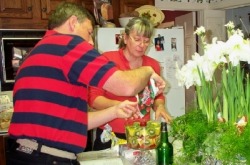
Christmas Day brought an unwelcome discovery of a bad tire on our rental car and the lack of available options to remedy it for another couple of days. We negotiated additional rental days to be added to the contract for the trouble (we had to have 2 new tires added, a puncture fixed in a 3rd and get it aligned). It didn’t stop us from moving onto NC to celebrate Christmas with Cathy’s family (thanks to Bonnie and Troy who drove). Cathy’s older sister even roped the 2 of us into making a dessert trifle, from scratch no less. It was an amazing thing to see the number of steps and ingredients involved in making something like this. It did taste good, though.
We were also welcome guests with our friend Cookie in our old neighborhood in Virginia, whose hospitality we enjoyed for an evening on our way to Rochester.
Happy New Year
So we managed to stay up to midnight and bring in the New Year with our boating friends in Nettles Island. We now turn our attention to getting ready for the next leg of our journey as we head south and (probably) east.
We were also welcome guests with our friend Cookie in our old neighborhood in Virginia, whose hospitality we enjoyed for an evening on our way to Rochester.
Happy New Year
So we managed to stay up to midnight and bring in the New Year with our boating friends in Nettles Island. We now turn our attention to getting ready for the next leg of our journey as we head south and (probably) east.

